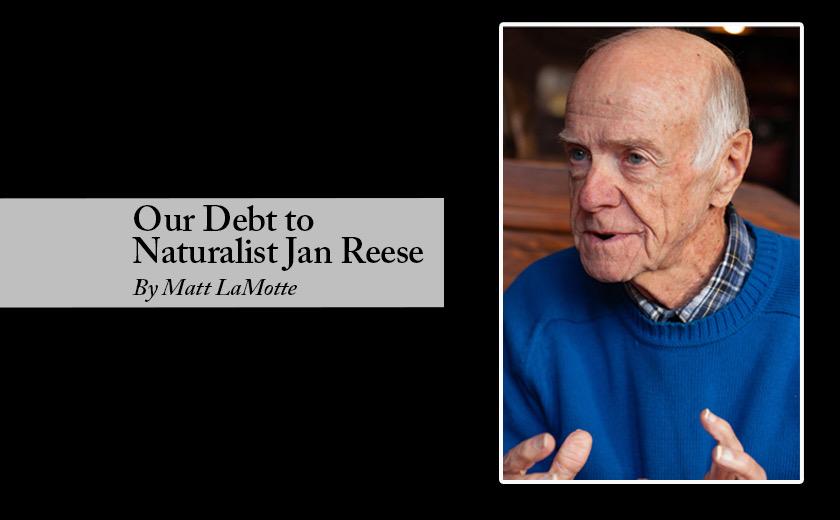“Man must be forever be on the alert and looking always at what is to be seen,” wrote one of America’s most famous naturalists, Henry David Thoreau, more than a century ago. But these words still hold true for today’s naturalists, conservationists and environmental scientists. And, certainly they apply to Jan Reese, a lifetime student of the Chesapeake Bay’s natural resources.
 Born and raised on Tilghman Island, Maryland, in the 1930’s and 1940’s, Reese, who now lives in nearby St. Michaels, became interested in the ecology of the Chesapeake Bay at an early age. He spent his youth observing, cataloging and preserving all kinds of Bay area plants, animals, and numerous other forms of wildlife. Inspired and mentored by St. Michael’s High School teacher Richard Kleen, he eventually focused his interests on birds.
Born and raised on Tilghman Island, Maryland, in the 1930’s and 1940’s, Reese, who now lives in nearby St. Michaels, became interested in the ecology of the Chesapeake Bay at an early age. He spent his youth observing, cataloging and preserving all kinds of Bay area plants, animals, and numerous other forms of wildlife. Inspired and mentored by St. Michael’s High School teacher Richard Kleen, he eventually focused his interests on birds.
This was the early 1950’s and the environmental movement had yet to take hold. Non-profit organizations such as the Chesapeake Bay Foundation and government bureaus like the Environmental Protection Agency had yet to be established. During the early 1960s, Reese expanded a project he’d begun on his own that focused on monitoring and cataloging the reproductive success of ospreys, aiding in national studies of these migratory birds. He spent two decades on the Chesapeake Bay researching and contributing to national and international studies on the causes of the decline of these fish-eating birds.
“From declining fish populations to the effects of the pesticide DDT on their breeding and nesting success, ospreys, in many ways, reflected the environmental malaise on the Bay,” Reese said. Expanding his efforts beyond preserving osprey nests on channel markers and buoys, he and Donald Merritt installed over 200 osprey platforms in local Bay tributaries. His research and field work helped to preserve and expand protection for the species. His dogged, selfless pursuit of preserving natural habitat inspired those who worked with him on this ground-breaking fieldwork. Several of his associates later pursued their own environmental passions and became leading researchers involved with plants, marine invertebrates, habitat preservation, environmental education, birds and other biological organisms.
Reese studied many other species incidentally encountered while carrying out Osprey studies (e.g., Mallard ducks, Snowy and Cattle Egrets, Great Blue and Green Herons, Common and Forester’s Terns, Barn Owls, Barn Swallows, Red-wing Blackbirds). Included among this menagerie were European Mute Swans. While attractive to humans, these large birds are a non-native, feral species in the Chesapeake Bay region, and they were interfering with native species like breeding ducks and wintering swans and geese, as well as some species of shorebirds, especially in their nesting habitats on the Bay. By the early 21st century, the Maryland Department of Natural Resources, in part by using Reese’s research data, instituted a plan to manage and reduce the Mute Swan population on the Chesapeake and its tributaries.
The election of Ronald Reagan in 1980 brought about a sea-change in the United States Government’s funding for environmental issues. Many programs of the Fish and Wildlife Service, the Environmental Protection Agency and other parts of the U.S. Interior Department – whose prior focus had been on determining the cause of decline in habitat quality and wildlife — were diminished and/or defunded. In the course of this downsizing, Reese’s cooperation and collaboration with the U.S. Fish & Wildlife Service came to an end. The balance of the 1980’s was spent without much field research or any supportive agency affiliation, so he mostly worked in construction.
Volunteering to lead plant and wildlife outings during this decade also played an important role In Reese’s life. This included organizations such as The Nature Conservancy, The Sierra Club, The Smithsonian Associates, Maryland Ornithological Society, regional bird clubs, and other scholarly venues. According to friend and life-long birder, Jeff Effinger, early morning or sunset bird walk with Reese was not to be missed. “Jan brought so much joy and enthusiasm to our birding trips,” said Effinger. “We always finished these trips knowing a lot more than when we started.”
During this time, Reese also was befriended during this time by a local farming family. Ed and Esther Burns, well-known plant and bird carvers who exhibited their painted wooden craft at the annual Waterfowl Festival in Easton, Maryland, and similar venues around the country. The Burns encouraged him to join them in their former turkey house, which they had converted into a studio for working, marketing, and teaching others how to carve and paint.. Reese said “his knowledge of many bird species form, structure and anatomical proportions aided his carving education from Ed while it was more a matter of learning from Ester how to accurately paint the carvings”. Making swift progress, he began entering his carvings in various competitions, where he garnered praise and success and quickly moved up to compete in the professional class where annually during the late-1980s – early-1990s he won blue ribbons at the World Competition held each April at the Ocean City Convention Center in Maryland and was subsequently invited to exhibit his carvings at prestigious venues like The Southeast Wildlife Exposition in Charleston, South Carolina, as well as the Easton Waterfowl Festival.
In the late 1980’s, with passage of Chesapeake Bay Critical Areas, Federal and State Wetland, and Forest Conservation Legislation Reese’s career took an unexpected turn when a regional engineering firm approached him about a job as an environmental consultant on their team. Since no one on their staff was familiar with the particulars about tidal lines, what was wetland and what was upland, or one tree species from another, all the while having to comply with the new environmental regulations in designing their customers’ proposed projects, it was a logical hire.
Thanks to his knowledge of plants, wildlife and environmental issues in and around the Chesapeake Bay, Reese was hired in 1990 as a staff environmentalist. “Working in the field fit well with my qualifications and passion,” he recalls. “Completing field work and writing up evaluation reports came naturally to me.” However, an economic recession in 1992 hit the construction and civil engineering industries very hard and Reese was out of a job with no other prospects for employment.
Now in his late 50’s, with little hope of being hired by anyone for any skilled position, he struck out on his own as an independent environmental consultant. The economy turned around by 1994 and Reese’ former employer became his best customer for over a decade.
Another economic recession hit in 2008, with the construction/civil engineering professions being hard hit again, leaving Reese with only contracts outside those industries, like The Nature Conservancy, and various municipal, county, state and federal government agencies, which were not dramatically impacted by the recession. One of those contracts was with the Maryland Department of Transportation, Maryland Port Authority and the 5th District, U.S. Army Corps of Engineers restoration project at Poplar Island in Chesapeake Bay a few miles northwest of Tilghman’s Island where he had been working since 2001. He found this a particularly interesting contract since, nearly 50 years ago, when it was a natural island before eroding away into the Chesapeake Bay, he had studied Ospreys there and was very familiar with its natural ecology.
Reese has had an affiliation with the Maryland Ornithological Society and its local Talbot County Chapter for over 60 years. Through decades the relationship has been beneficial to each party with financial compensation for expendable equipment of some research projects in exchange for volunteer lectures, leader of various types of wildlife outings, physical labor, professional consultation, advice and lead on some organization sanctuary projects. The state organization has recognized him with various awards through the decades while the local chapter recently awarded Reese a Lifetime Achievement Award for his invaluable leadership and service.
Unfortunately, in 2014, a change in his health resulted in Reese no longer being able to do field work, forcing him to give up employment. He continues to cooperate and consult with other researchers on many scientific research projects, compile and analyze decades of collected data, and write scientific papers for publication.
Researcher, habitat and wildlife preservationist, naturalist and environmentalist, Jan Reese has proven himself to be a dedicated advocate for the protection and preservation of the Chesapeake Bay. “There are few places around the world with as much natural beauty and diversity as the Bay,” he said. “I hope that, in some small way, I’ve helped preserve that legacy.”
Matt LaMotte is is member of the Chesapeake Bay Environmental Center in Queenstown, MD. The author wishes to thank Terry Allen,Wayne Bell, Jeff Effinger, George Fenwick, Steve Hamblin, Donald “Mutt” Merritt and others, named and unnamed, who supported Jan along the way on his journey.



Bob Moores says
Thanks for the great article, Matt!
Terye Reese Knopp says
Great article Matt. I am Jan’s daughter and as you have written he has devoted his entire life to the research and preservation of our beloved Chesapeake Bay.
Marguerite Whilden says
In 2017, I wrote to the membership of the Poplar Island Working Group requesting their consideration of additional diamondback terrapin data. According to the pre-construction surveys conducted by the Corps of Engineers in 1995, there was little evidence of a terrapin population near the Poplar Island site. As such, no one expected terrapins to arrive so soon and in such abundance. I suggested perhaps the unexpected arrival of hundreds of terrapins to the project site beginning in 2001 had been influenced by a nearby terrapin study initiated by DNR Fisheries. Out of over 70 members of the Working Group, only Jan Reese replied. I will never forget his kind consideration.